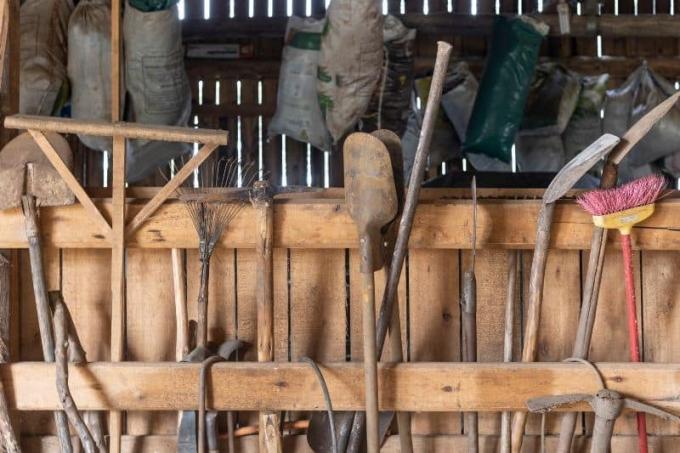
Sanding the lawn once a year is part of proper lawn care. The correct procedure is not rocket science. This article explains which tools are required for lawn sanding.
In a nutshell
- most tools in gardens already available
- no special tools required
- Don't forget the prep work
- pay attention to light means of transport
- Maintain tools regularly
Table of contents
- Benefits of Sanding
- Necessary tools
- Tools for preparatory work
- Sanding tools for lawn
- The right sand
- Sanding the lawn: instructions
- frequently asked Questions
Benefits of Sanding
Regularly sanding your lawn is good for your lawn, because sand
- improves ventilation and thus promotes root growth of the grass
- protects against waterlogging and compaction
- prevented thatch and moss formation
- increases the resilience of the lawn
A notice: You do not have to sand soil that is already sandy.
Necessary tools

The tools necessary for sanding the lawn are already available in most gardens anyway, because they are already used for a variety of other gardening tasks. Many forget, however, that extensive preparatory work is also necessary before the sand can actually be spread. Below we list the most important tools you need in order to let the lawn enjoy the benefits mentioned above.
Tools for preparatory work
mowing machine

Before the lawn can be sanded, it is necessary to shorten it to about three centimeters in length. This should be done with an appropriate mowing machine happen, who has sharp knives, so that the grass is cut and not torn off. Important when choosing the right mower:
- the right size
- electrical, mechanical or robot lawn mower
- adjustable cutting height
- existing catch basket
- other special features, such as integrated scarifying function
A notice: It doesn't make sense to just mulch the lawn before sanding it. The blades of grass left behind prevent the sand from penetrating the soil well.
scarifier
So that the sand can get into the ground better, it makes sense to cover the lawn after mowing scarify. The top layer of soil is cut open. Matted grass and moss are removed from the lawn. There are electric scarifiers, but there are also purely mechanical ones that require a lot of power. It is important that with a scarifier without a collecting basket, the area must then be thoroughly cleaned of all plant residue.

Tip: If you don't want to buy a scarifier, you can also get one at the local hardware store and in a tool rental shop to rent.
Sanding tools for lawn
shovel
The sand is spread on the lawn with the shovel. Any shovel that is available in the garden is suitable for this. A spade is less suitable. The shovel should have a stable but also light handle, which reduces the necessary effort.
Tip: If you want to sand larger areas, you can spread the sand with a suitable spreader.
rake
The sand is distributed in the grass with a rake or a rake. A rake is more suitable because the tines are more stable and the sand can be worked better into the grass. A rake is better suited for cleaning the lawn of any plant debris before sanding.
wheelbarrow

If the sand has to be transported a long distance through the garden, a wheelbarrow is better than buckets, which have to be carried. The cart should have a lightweight construction.
Tip: Before starting work, check the tire pressure and inflate if necessary, this makes the work easier.
sprinkling
After sanding, it is necessary to sprinkle the area with water if no rain is to be expected. The water washes the sand into deeper soil layers. Watering cans are unsuitable for sprinkling larger areas and with the Hose the result becomes too uneven. It is best to use the normal lawn sprinkler system.
The right sand
In order for the sanding of the lawn to be successful, in addition to the right tools, the right sand is crucial. It should have the following properties:
- Grain size 2 to 3 mm
- washed so it doesn't clump
- free from unwanted residues and additives
- as dry as possible, this makes it easier to spread
We recommend sharp, pure quartz sand.
Sanding the lawn: instructions

If you have the right tool and the right sand selected, you can start sanding the lawn:
- Mowing and scarifying the lawn
- Thoroughly clean the surface
- Apply sand evenly over a large area with a shovel
- work into the soil with a rake
- Then water the area
frequently asked Questions
It makes the most sense to sand the lawn at the beginning of the growing season. That is around the end of April to mid-May and depends on the specific temperatures. Once they hit double digits, the grass starts to grow and the timing is right.
It depends on the soil conditions and how often sanding is done. More sand should be applied to compacted, loamy soils, up to about 10 kg per square meter. For lighter soils, 4 kg is sufficient. As a rule of thumb, the blades of grass should still be clearly visible after sanding.
This is not recommended, but it can be done in an emergency. If the play sand is washed quartz sand with the right grain size, then it makes no difference whether this or special lawn sand is used.



